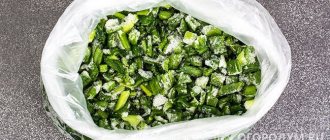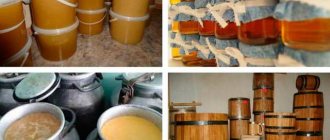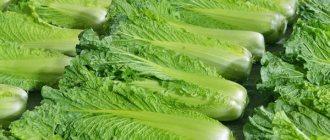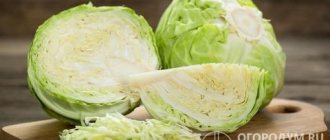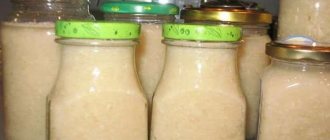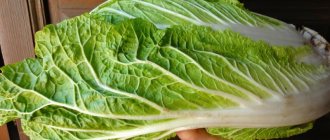Sauerkraut is one of the most famous everyday and holiday dishes. With a large volume of preparation, the question arises about how to store the product to stop the fermentation process. Freezing is one of the options so that the snack does not lose its beneficial properties. How to do this correctly is discussed in this article.
- Is it possible to freeze sauerkraut?
- Points for and against
- Properties of frozen sauerkraut
- How the composition and consistency will change
- How to freeze correctly
- How to freeze cabbage: step-by-step instructions
- How to defrost
- How to use
- Other storage methods
- Storage on the balcony
- Cold storage
- Tips on the topic
- Conclusion
Is it possible to store sauerkraut in the freezer?
Sauerkraut is suitable for freezing. At the same time, many of its properties are preserved, although some qualities change. Freezing the product is recommended when it is planned to be used for heat treatment.
Advantages and disadvantages
Freezing pickled vegetables is easy. Many people who actively use it in cooking find this method very convenient.
Proper packaging of sauerkraut for freezing saves a lot of space
Pros:
- increasing shelf life;
- consistency of taste;
- preservation of most useful elements, KBZHU;
- simplicity and speed of use of the finished product.
Minuses:
- loss of hardness, crunch;
- deterioration in appearance;
- less free space in the freezer;
- decrease in vitamin C content.
Some disadvantages of freezing food are relative. Firmness and crunch are important when eaten fresh, but their loss is not important when cooked. This also applies to appearance.
Properties of frozen sauerkraut
The product retains its nutritional value. After defrosting for another 2-3 hours it remains at the same level, but then begins to decrease. This factor does not matter if the workpiece is immediately consumed as food or subjected to heat treatment.
Freezing leads to a decrease in the concentration of vitamin C. However, the content of other acids and other valuable elements remains unchanged.
Sauerkraut does not lose its crunch immediately. After defrosting the product, it will keep for another 2-3 hours.
Comment! The change in the properties of sauerkraut is associated with its defrosting. A few hours after it, fermentation processes resume.
Procedure for pickling and freezing
Wash the carrots, peel them and grate them on a coarse grater. Remove the top leaves from the cabbage. Shred the way you like best.
Mix the vegetables and mash them a little with the salt to release the juice. At the bottom of a cleanly washed tank you need to lay several cabbage leaves and throw in some black peppercorns.
We lay the mass of cabbage and carrots in layers, compacting it tightly. Arrange the layers with dill and pepper umbrellas, generously sprinkle with sugar.
Place a few more large leaves on top and press the cabbage into a circle. A stone is placed on it.
Within a couple of hours, juice should appear on the surface.
The product will ferment for several days. It must be pierced with a wooden stick to the very bottom three times a day. In this way, the gases accumulating in the thickness of the workpiece are removed.
Until fermentation becomes less active, keep the cabbage in a warm room. Then it is taken out into the cold. It’s good if at this time the temperature outside has already dropped below zero.
An open loggia or any extension of a country house, for example, a terrace, is suitable as a storage place. You can move the tank to the cellar if it is cold enough there.
The point of such storage is that the cabbage is frozen and thus retains all the beneficial substances. The fermentation processes stop, the vegetables remain crisp and quite firm.
If you made the preparation at the end of September and it is still warm outside, you can freeze the cabbage in plastic bags and store it in the freezer.
The taste qualities of such a product will not be inferior to barrel ones.
If necessary, one bag is removed and defrosted at room temperature. You can transfer the workpiece to the bottom shelf of the refrigerator in advance so that the process takes place gradually.
Sauerkraut contains vitamins A, B, C, K, U, iodine, pectins, lactic acid, as well as magnesium, calcium and zinc. The product is considered a natural antioxidant. Supermodel Heidi Klum, who has shone on the catwalk and television screen for decades, starts every morning with a glass of sauerkraut pickle.
How to freeze correctly
It is best to freeze sauerkraut in the appropriate compartment of the refrigerator or in a separate chest or cabinet. Bags are usually used to package raw materials. The packaging is chosen to be dense; it is best to take the material specifically for freezing. An alternative option is plastic jars and containers.
It's easy to freeze the product:
- Squeeze the cabbage mixture to remove the liquid.
- Place the raw materials in bags or containers.
- Seal the package hermetically.
- Freeze filled bags.
It is better to start the process from the blast freezing department, if there is one. The filled bags are laid out in one layer. When the contents are completely frozen, you can put them tightly in one place. If packages are used, it is more convenient to combine them. One option is to put the blanks in a container.
There is no need to get rid of the brine when freezing. It is recommended to pour it into a bottle and store it in the refrigerator. Then this brine can be poured over the defrosted mass. This better preserves the taste and benefits.
Freezing can be organized in two stages. First, the cabbage is laid out on a board or flat surface. After freezing in this form, the raw materials are packaged and removed for permanent storage.
It is convenient to use zip-lock bags for freezing various raw materials
How to freeze cabbage: step-by-step instructions
Vegetables should be frozen according to the following instructions:
- If possible, vegetables with a dense structure are selected, preferably large-cut;
- cabbage is laid out (without salt) in plastic bags or containers of 500-1000 grams;
- in the upper part of the product storage container you need to leave about 20% of free space for expansion during thawing;
- you need to squeeze out the air from the bags, but this cannot be done from containers, so you can fill them completely;
- On bags and other containers you can indicate the freezing date with a marker;
- The bags are placed in the freezer.
Important! This product can be stored in the freezer for up to a year. At the same time, its beneficial qualities immediately after defrosting will be the same as before freezing.
Terms and conditions of storage
Typically, freezer compartments in refrigerators maintain temperatures between -6 and 24 °C. For storing sauerkraut, it is optimal to set it to -18 °C. A larger indicator is needed only at the beginning for shock freezing.
Temperature changes should not be allowed. If there is a short-term power outage, then there is nothing to worry about. The refrigerator works like a thermos, maintaining the temperature for hours if you do not open it.
When frozen, sauerkraut can be stored for up to eight months. For maximum life, it is important to eliminate temperature changes and use freshly prepared and high-quality raw materials.
Comment! When temperatures change, the consistency of the product changes. The appearance also suffers - the color becomes grayish.
Tips on the topic
Basic tips to help increase shelf life and maintain product quality at a high level:
- To maximize the preservation of nutrients, the cabbage is covered to the top with brine. It is removed from the liquid immediately before serving. If the brine does not cover all the cabbage, it is recommended to use a press to press down the bulk of the workpiece.
- Regular sugar will prevent the cabbage from turning sour. It is used as a preservative that slows down fermentation. Place 1 tablespoon on a three-liter jar.
- Vegetable oil is another powerful preservative. It is poured onto the surface of the brine to prevent oxygen from reaching the cabbage.
- If the product is slightly peroxided, it is used for preparing hot dishes. Before using, sprinkle the cabbage with 1 teaspoon of sugar.
- To protect the product from mold, mustard seeds or mustard powder are added to the product. But this changes the taste of the product slightly - be careful with the quantity.
- Cranberries added during the preparation of sauerkraut extend the shelf life by about 50%.
- Horseradish prevents fungi from developing, which also increases the shelf life of the product. It is added to ready-made pickles so that the fermentation process is not interrupted ahead of time.
Defrosting and application
You need to defrost sauerkraut if you plan to use it fresh. In this case, take out a portion only for one time. There is no need to prepare anything in advance. This portion is placed in a suitable container and placed in the refrigerator for several hours. You can put it there overnight.
If heat treatment is intended, then the workpiece does not need to be defrosted. It is immediately added to the rest of the ingredients at the right time.
Frozen sauerkraut can be used in preparing various dishes:
- cabbage soup, cabbage soup, solyanka and other soups;
- stews and other vegetable dishes;
- bakery;
- cutlets;
- lazy cabbage rolls;
- casseroles;
- bigos and other main courses with meat.
Ingredients and Tools
We don't need anything unusual. Only a standard set of tools and accessories:
- enamel tank with a capacity of 25 l with a lid;
- circle for bending made of wood;
- a stone that will be used as a load;
- long wooden stick.
You don’t need a lot of products either, this is a feature of the preparation.
For pickling, we take cabbage of those varieties that usually store well. The heads of cabbage should be strong and dense, with a slight crunch when squeezed. Choose carrots that are juicy and not too big.
You will also need salt, sugar and black peppercorns, as well as several umbrellas of ripe dill.
Other ways to store sauerkraut
Instead of a freezer, the workpiece can be stored on the balcony. The disadvantage of this method is the temperature difference. During a thaw, the product may completely defrost.
There are other options:
- cellar - recommended temperature 0-5 °C, shelf life up to 4-5 months;
- refrigerator - in an airtight container the product will last up to three months, after opening 1.5 weeks;
- room conditions are an option for short-term storage, for a maximum of three days.
When choosing methods for preserving workpieces, it is important to consider that fermentation starts again at a temperature of 10 °C
Methods of eating
It’s not for nothing that frozen cabbage is considered one of the most delicious snacks. It is perfect for the holiday table and for daily use.
Crispy tender leaves and fresh taste instantly bring the product a whole army of admirers. Try fermenting cabbage in this way, and there will be no end to those who want to try an unusual new product. Colleagues and neighbors will line up to get at least a couple of spoons of the aromatic delicacy.
The preparation can be made into a vegetable soup or added to stewed cabbage at the very end of cooking. And the lactic acid contained in the brine will add a spicy, spicy note to any simple dish.
- Author: Zimina Tatyana
Rate this article:
- 5
- 4
- 3
- 2
- 1
(0 votes, average: 0 out of 5)
Share with your friends!
Properties of frozen sauerkraut
The values of calories and BJU indicators can be stored in thawed cabbage for several hours (2-3 hours). At this time, the product has the same properties as before freezing.
According to BJU, the picture is as follows (data per 100 g):
- proteins - 1.6 g;
- fats - 0.1 g;
- carbohydrates - 5.2 g.
However, within a couple of hours after defrosting, fermentation processes begin in the product , which change properties, increase acidity and lead to loss of consumer qualities.
How to defrost
In most cases, sauerkraut does not need to be thawed before using. To prepare borscht and other hot dishes, you can use frozen.
If you still need to defrost, just remove the product from the freezer and put it in the refrigerator for several hours. After this it will be ready for use.
How to use
Thawed cabbage is used in the same way as regular cabbage. That is, it is used for making pies, cabbage soup, shanks, potatoes, etc. But it is better not to prepare salads from defrosted cabbage - there will be no characteristic crunch.
What to do to prevent sauerkraut from peroxidation?
SHORT
- On top of the vegetables salted in an open bowl, I place horseradish root cut into thin shavings - this way the vegetables will not become moldy, and their taste will significantly improve.
- To prevent air from entering the pickles, you can pour a little vegetable oil on top.
Interesting materials:
How to wash carpets in a washing machine? How to wash leather Nike sneakers? How to wash the inside of leather sneakers? How to wash leather motorcycle gloves? How to wash leather gloves in a machine? How to wash leather gloves? How to wash leather shorts? How to wash leather pants in a machine? How to wash a goat shawl? How to wash Adidas sneakers?

